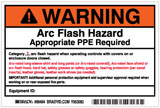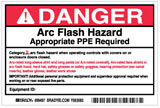Arc Flash Evaluation
OSHA (Occupational Safety and Health Administration) has recently announced their intention to enforce Arc Flash safety procedures as outlined in the NEC (National Fire Protection Association) 70E standard.
Van Ert Electric has a program in-house that will make the necessary calculations and generate labels required for electrical panels and equipment. Let us help you comply, by working with your employees to determine:
- Flash Hazard boundary
- Limited Approach Distance
- Restricted Approach Distance
- Prohibited Approach Distance
- Shock Hazard
- Appropriate PPE (Personal Protection Equipment)


Arcing from an electrical fault produces incredibly high temperatures. It can easily exceed 30,000 degrees F— hotter than the surface of the sun! Arcing causes air to expand dramatically and metal conductors to vaporize. Copper expands 67,000 times when it is converted from solid to vapor. This rapid expansion of air and metal vapor produce an intensely hot blast. Too often, employees, who are not wearing adequate Personal Protective Equipment (PPE), are seriously injured or killed if an electrical arc occurs when they are working on electrical equipment.
Burns account for about 80% of all injuries that result from electrical accidents. These burns usually result from exposure to intense heat and molten metal generated by an arcing fault. Such burns are typically second and third degree in nature and can frequently cause death a few days after the accident. Arcing causes air and metal vapor to expand at such a rapid rate that it produces a blast similar to the force of an explosion—enough to throw a worker’s body across the room.
Arc flash studies/evaluations should be used to determine the minimum level of Personal Protective Equipment (PPE) workers must wear when they are near exposed energized equipment. For the past several years, OSHA regulations have required hazard assessments and use of appropriate PPE in the work place. An arc flash study provides a quantifiable assessment of the hazard level.
**Statistical information taken from an Emerson case study.
For more information on arc flash evaluation, click here to contact a representative from one of our offices.
